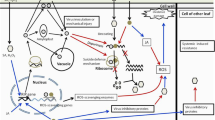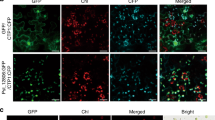Abstract
We have isolated a gene encoding a ribosome-inactivating protein (RIP) from Phytolacca insularis, designated as P. insularis antiviral protein 2 (PIP2). The PIP2 gene contained an open reading frame encoding a polypeptide of 315 amino acids. The deduced amino acid sequence of PIP2 was similar to those of other RIPs from Phytolacca plants. Recombinant PIP2 was expressed in Escherichia coli and was used to investigate its biological activities. Recombinant PIP2 inhibited protein synthesis in rabbit reticulocyte lysate by inactivating ribosomes through N-glycosidase activity. It also exhibited antiviral activity against tobacco mosaic virus (TMV). Expression of the PIP2 gene was developmentally regulated in leaves and roots of P. insularis. Furthermore, expression of the PIP2 gene was induced in leaves by mechanical wounding. The wound induction of the PIP2 gene was systemic. Expression of the PIP2 gene also increased in leaves in a systemic manner after treatment with jasmonic acid (JA) and abscisic acid (ABA), but not with salicylic acid (SA). These results imply that plants have employed the systemic synthesis of the defensive proteins to protect themselves more efficiently from infecting viruses.
Similar content being viewed by others
References
Ausubel, F.M., Brent, R., Kingston, R.E., Moore, D.D., Seidman, J.G., Smith, J.A. and Struhl, K. 1987. Current Protocols in Molecular Biology. Wiley Interscience, New York.
Barbieri, L., Battelli, M.G. and Stirpe, F. 1993. Ribosomeinactivating proteins form plants. Biochim. Biophys. Acta 1154: 237–282.
Bass, H.W., Webster, C., O'Brian, G.R., Roberts, J.K.M. and Boston, R.S. 1992. A maize ribosome-inactivating protein is controlled by the transcriptional activator Opaque-2. Plant Cell 4: 225–234.
Becker, W. and Apel, K. 1993. Differences in gene expression between natural and artificially induced leaf senescence. Planta 189: 74–79.
Birkenmeier, G.F. and Ryan, C.A. 1998. Wound signaling in tomato plants: evidence that ABA is not a primary signal for defense gene activation. Plant Physiol. 117: 687–693.
Bolognesi, A., Barbieri, L., Abbondanza, A., Falasca, A.I., Carnicelli, D., Battelli, M.G. and Stirpe, F. 1990. Purification and properties of new ribosome-inactivating proteins with RNA N-glycosidase activity. Biochim. Biophys. Acta 1087: 293–302.
Bonness, M.S., Ready, M.P., Irvin, J.D. and Mabry, T.J. 1994. Pokeweed antiviral protein inactivates pokeweed ribosomes; implications for the antiviral mechanism. Plant J. 5: 173–183.
Bowles, D.J. 1990. Defense-related proteins in higher plants. Annu. Rev. Biochem. 59: 873–907.
Bradford, M.M. 1976. A rapid and sensitive method for the quantitation of microgram quantities of protein utilizing the principle of protein-dye binding. Anal. Biochem. 72: 248–254.
Carzaniga, R., Sinclair, L., Fordham-Skelton, A.P., Harris, N. and Croy R.R.D. 1994. Cellular and subcellular distribution of saporins, type-1 ribosome-inactivating proteins, in soapwort (Saponaria officinalis L.). Planta 194: 461–470.
Chaudhry, B., Müller-Uri, R., Cameron-Mills, V., Gough, S., Simpson, D., Skriver, K. and Mundy, J. 1994. The barley 60 kDa jasmonate-induced protein (JIP60) is a novel ribosomeinactivating protein. Plant J. 6: 815–824.
Chen, Z.C., White, R.F., Antoniw, J.F. and Lin, Q. 1991. Effect of pokeweed antiviral protein (PAP) on the infection of plant viruses. Plant Path. 40: 612–620.
Chomczynski, P. and Sacchi, N. 1987. Single-step method of RNA isolation by acid guanidinium thiocyanate-phenol-chloroform extraction. Anal. Biochem. 162: 156–159.
de Benito, F.M., Iglesias, R., Ferreras, J.M., Citores, L., Camafeita, E., Méndez, E. and Girbés, T. 1998. Constitutive and inducible type 1 ribosome-inactivating proteins (RIPs) in elderberry (Sambucus nigra L.). FEBS Lett. 428: 75–79.
Dong, X. 1998. SA, JA, ethylene, and disease resistance in plants. Curr. Opin. Plant Biol. 1: 316–323.
Durner, J., Shah, J. and Klessig, D.F. 1997. Salicylic acid and disease resistance in plants. Trends Plant Sci. 2: 266–274.
Endo, Y., Mitsui, K., Motizuki, M. and Tsurugi, K. 1987. The mechanism of action of ricin and related toxic lectins on eukaryotic ribosomes: the site and characteristics of the modification in 28S ribosomal RNA caused by the toxins. J. Biol. Chem. 262: 5908–5912.
Farmer, E.E., Johnson, R.R. and Ryan, C.A. 1992. Regulation of expression of proteinase inhibitor genes by methyl jasmonate and jasmonic acid. Plant Physiol. 98: 995–1002.
Girbés, T., de Torre, C., Iglesias, R., Ferreras, J.M. and Méndez, E. 1996. RIP for viruses. Nature 379: 777–778.
Hartley, M.R., Legname, G., Osborn, R., Chen, Z. and Lord, J.M. 1991. Single-chain ribosome inactivating proteins from plants depurinate Escherichia coli 23S ribosomal RNA. FEBS Lett. 290: 65–68.
Hartley, M.R., Chaddock, J.A. and Bonness, M.S. 1996. The structure and function of ribosome-inactivating proteins. Trends Plant Sci. 1: 254–260.
Higgins, D.G., Bleasby, A.J. and Fuchs, R. 1992. Clustal V: improved software for multiple sequence alignment. Comput. Appl. Biosci. 8: 189–191.
Houston, L.L., Ramakrishnan, S. and Hermodson, M.A. 1983. Seasonal variations in different forms of pokeweed antiviral protein, a potent inactivator of ribosomes. J. Biol. Chem. 258: 9601–9604.
Ikeda, T., Takanami, Y., Imaizumi, S., Matsumoto, T., Mikami, Y. and Kubo, S. 1987. Formation of anti-plant viral protein by Mirabilis jalapa L. cells in suspension culture. Plant Cell Rep. 6: 216–218.
Kataoka, J., Habuka, N., Masuta, C., Miyano, M. and Koiwai, A. 1992. Isolation and analysis of a genomic clone encoding a pokeweed antiviral protein. Plant Mol. Biol. 20: 879–886.
Katzin, B.J., Collins, E.J. and Robertus, J.D. 1991. Structure of ricin A-chain at 2.5 Å. Proteins 10: 251–259.
Koiwa, H., Bressan, R.A. and Hasegawa, P.M. 1997. Regulation of protease inhibitors and plant defense. Trends Plant Sci. 2: 379–384.
Leah, R., Tommerup, H., Svendsen, I. and Mundy, J. 1991. Biochemical and molecular characterization of three barley seed proteins with antifungal properties. J. Biol. Chem. 266: 1564–1573.
Lee-Huang, S., Huang, P.L., Kung, H.F., Li, B.Q., Huang, P.L., Huang, P., Huang, H.I. and Chen, H.C. 1991. TAP 29: an anti-human immunodeficiency virus protein from Trichosanthes kirilowii that is nontoxic to intact cells. Proc. Natl. Acad. Sci. USA 88: 6570–6574.
Leung, J. and Giraudat, J. 1998. Abscisic acid signal transduction. Annu. Rev. Plant Physiol. Plant Mol. Biol. 49: 199–222.
Lin, Q., Chen, Z.C., Antoniw, J.F. and White, R.F. 1991. Isolation and characterization of a cDNA clone encoding the antiviral protein from Phytolacca americana. Plant Mol. Biol. 17: 609–614.
Lodge, J.K., Kaniewski, W.K. and Tumer, N.E. 1993. Broadspectrum virus resistance in transgenic plants expressing pokeweed antiviral protein. Proc. Natl. Acad. Sci. USA 90: 7089–7093.
Logemann, J., Jach, G., Tommerup, H., Mundy, J. and Schell, J. 1992. Expression of a barley ribosome-inactivating protein leads to increased fungal protection in transgenic tobacco plants. Bio/technology 10: 305–308.
Mason, H.S. and Mullet, J.E. 1990. Expression of two soybean vegetative storage protein genes during development and in response to water deficit, wounding, and jasmonic acid. Plant Cell 2: 569–579.
Moon, Y.H., Jeon, H.S., Choi, K.W. and Lee, J.S. 1994. Development of virus-resistant potato by expression of Phytolacca antiviral protein. Mol. Cells 4: 183–188.
Moon, Y.H., Song, S.-K., Choi, K.W. and Lee, J.S. 1997. Expression of a cDNA encoding Phytolacca insularis antiviral protein confers virus resistance on transgenic potato plants. Mol. Cells 7: 807–815.
Müller, M., Dues, G., Balconi, C., Salamini, F. and Thompson, R.D. 1997. Nitrogen and hormonal responsiveness of the 22 kDa δ-zein and b-32 genes in maize endosperm in displayed in the absence of the transcriptional regulator Opaque-2. Plant J. 12: 281–291.
Munishkin, A. and Wool, I.G. 1995. Systematic deletion analysis of ricin A-chain function: single amino acid deletions. J. Biol. Chem. 270: 30581–30587.
Peñ a-Cortés, H., Prat, S., Atzorn, R., Wasternack, C. and Willmitzer, L. 1996. Abscisic acid-deficient plants do not accumulate proteinase inhibitor II following systemin treatment. Planta 198: 447–451.
Poyet, J.-L., Hoeveler, A. and Jongeneel, C.V. 1998. Analysis of active site residues of the antiviral protein from summer leaves from Phytolacca americana by site-directed mutagenesis. Biochem. Biophys. Res. Commun. 253: 582–587.
Prestle, J., Schönfelder, M., Adam, G. and Mundry, K.-W. 1992. Type 1 ribosome-inactivating proteins depurinate plant 25S rRNA without species specificity. Nucl. Acids Res. 20: 3179–3182.
Ready, M.P., Brown, D.T. and Robertus, J.D. 1986. Extracellular localization of pokeweed antiviral protein. Proc. Natl. Acad. Sci. USA 83: 5053–5056.
Reinbothe, S., Mollenhauer, B. and Reinbothe, C. 1994a. JIPs and RIPs: the regulation of plant gene expression by jasmonates in response to environmental cues and pathogens. Plant Cell 6: 1197–1209.
Reinbothe, S., Reinbothe, C., Lehmann, J., Becker, W., Apel, K. and Parthier, B. 1994b. JIP60, a methy jasmonate-induced ribosomeinactivating protein involved in plant stress reactions. Proc. Natl. Acad. Sci. USA 91: 7012–7016.
Reymond, P. and Farmer, E.E. 1998. Jasmonate and salicylate as global signals for defense gene expression. Curr. Opin. Plant Biol. 1: 404–411.
Rippmann, J.F., Michalowski, C.B., Nelson, D.E. and Bohnert, H.J. 1997. Induction of a ribosome-inactivating protein upon environmental stress. Plant Mol. Biol. 35: 701–709.
Ryan, C.A. and Pearce, G. 1998. Systemin: a polypeptide signal for plant defensive genes. Annu. Rev. Cell Dev. Biol. 14: 1–17.
Sambrook, J., Fritsch, E.F. and Maniatis, T. 1989. Molecular Cloning: A Laboratory Manual, 2nd ed., Cold Spring Harbor Laboratory Press, Plainview, NY.
Sanger, F., Nicklen, S. and Coulson, A.R. 1977. DNA sequencing with chain-terminating inhibitors. Proc. Natl. Acad. Sci. USA 74: 5463–5467.
Schaller, A. and Ryan, C.A. 1995. Systemin: a polypeptide defense signal in plants. BioEssays 18: 27–33.
Stirpe, F., Barbieri, L., Battelli, M.G., Soria, M. and Lappi, D.A. 1992. Ribosome-inactivating proteins from plants: present status and future prospects. Bio/technology 10: 405–412.
Stirpe, F., Barbieri, L., Gorini, P., Valbonesi, P., Bolognesi, A. and Polito, L. 1996. Activities associated with the presence of ribosome-inactivating proteins increase in senescent and stressed leaves. FEBS Lett. 382: 309–312.
Taylor, S., Massiah, A., Lomonossoff, G., Roberts, L.M., Lord, J.M. and Hartley, M. 1994. Correlation between the activities of five ribosome-inactivating proteins in depurination of tobacco ribosomes and inhibition of tobacco mosaic virus infection. Plant J. 5: 827–835.
Titarenko, E., Rojo, E., Leó n, J. and Sánchez-Serrano, J.J. 1997. Jasmonic acid-dependent and-independent signaling pathways control wound-induced gene activation in Arabidopsis thaliana. Plant Physiol. 115: 817–826.
Tregear, J.W. and Roberts, L.M. 1992. The lectin gene family of Ricinus communis: cloning of a functional ricin gene and three lectin pseudogenes. Plant Mol. Biol. 18: 515–525.
Walsh, T.A., Morgan, A.E. and Hey, T.D. 1991. Characterization and molecular cloning of a proenzyme form of a ribosomeinactivating protein from maize: novel mechanism of proenzyme activation by proteolytic removal of a 2.8-kilodalton internal peptide segment. J. Biol. Chem. 266: 23422–23427.
Wasternack, C. and Parthier, B. 1997. Jasmonate-signalled plant gene expression. Trends Plant Sci. 2: 302–307.
Author information
Authors and Affiliations
Rights and permissions
About this article
Cite this article
Song, SK., Choi, Y., Moon, Y.H. et al. Systemic induction of a Phytolacca insularis antiviral protein gene by mechanical wounding, jasmonic acid, and abscisic acid. Plant Mol Biol 43, 439–450 (2000). https://doi.org/10.1023/A:1006444322626
Issue Date:
DOI: https://doi.org/10.1023/A:1006444322626




